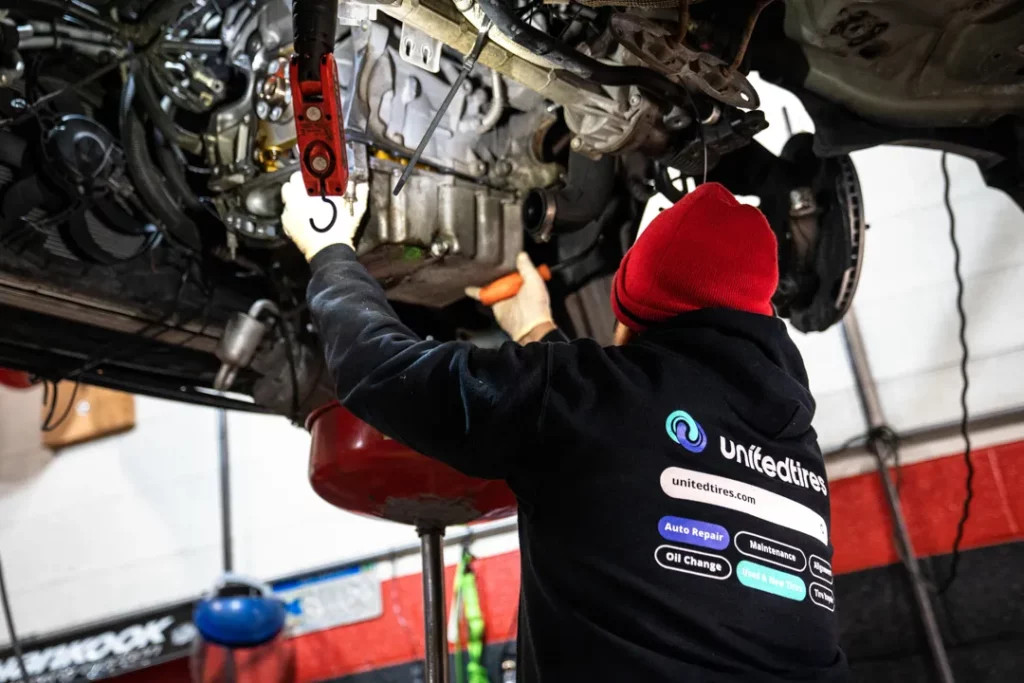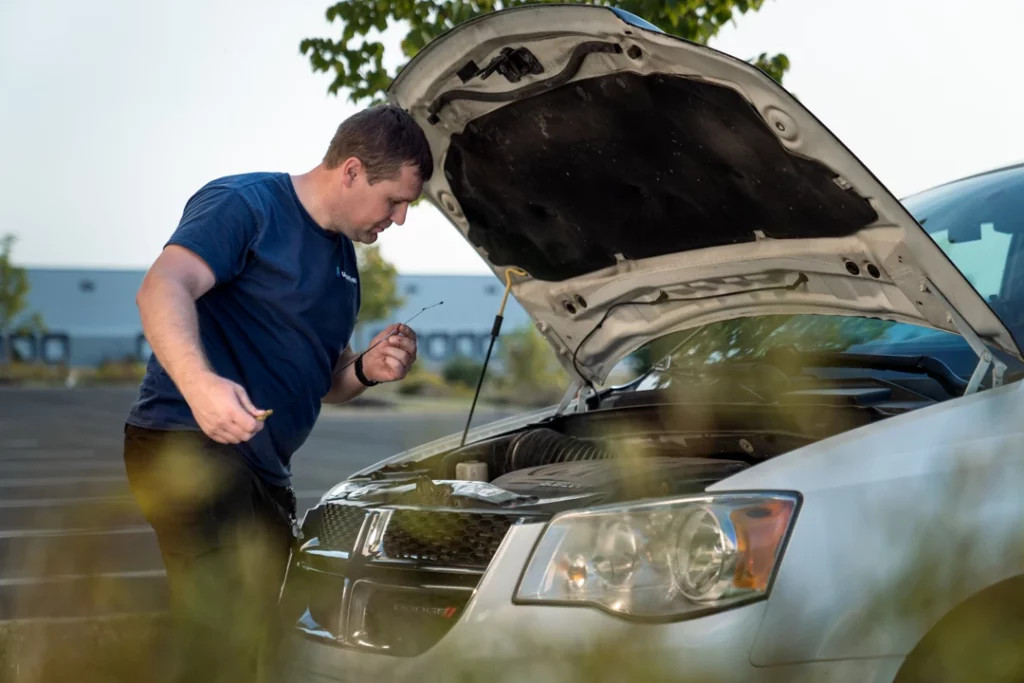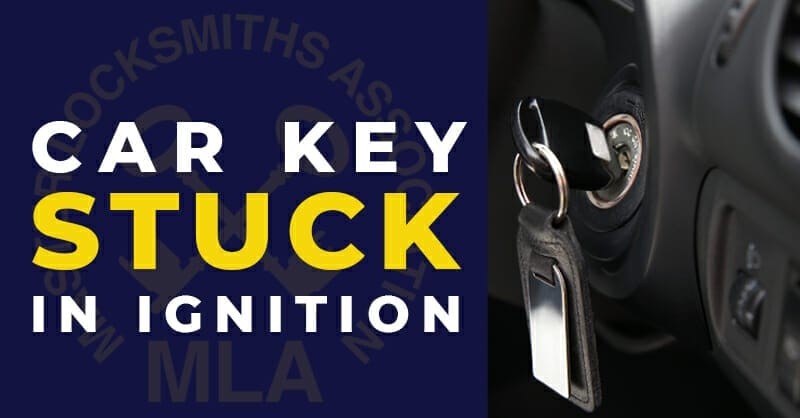**How to Fix Low Oil Pressure in Car: A Comprehensive Guide**

Fixing low oil pressure in your car is crucial for maintaining engine health. CARDIAGTECH.NET provides a detailed guide to help you diagnose and address the common causes of low oil pressure, ensuring optimal engine performance and preventing costly repairs. Learn about symptoms, potential dangers, and maintenance tips to keep your engine running smoothly with our expert advice on engine lubrication and oil system maintenance.
1. Understanding the Importance of Engine Oil and Pressure
Why is engine oil pressure so critical? Engine oil is the lifeblood of your car’s engine, and maintaining the correct oil pressure is essential for its longevity and performance. According to a study by the American Automobile Association (AAA), lubrication-related issues are a leading cause of engine failure.
The engine is full of moving parts that must move smoothly without grinding or rubbing against each other. Engine oil needs to flow freely to lubricate these parts, ensuring proper operation. This movement requires a certain amount of pressure; if the oil pressure drops too low, the engine parts won’t be adequately lubricated, leading to damage. This lack of lubrication can result in severe problems, including engine failure. Maintaining proper oil pressure is vital for preventing these issues and ensuring your engine runs efficiently.
2. Recognizing the Signs of Low Engine Oil Pressure
What are the key indicators of low engine oil pressure? Recognizing the signs of low engine oil pressure early can prevent significant engine damage. The following symptoms indicate a potential problem:
- Engine Noise: Listen for unusual engine noises. Insufficient lubrication causes increased friction between moving parts, leading to knocking or ticking sounds.
- Excessive Oil Consumption: Frequent oil top-ups could indicate low oil pressure. Internal leaks or worn piston rings and valve seals can cause engines with low oil pressure to consume more oil, increasing costs and requiring regular monitoring.
- Exhaust Smoke: Blue smoke from the exhaust indicates oil leaking into the combustion chamber due to low engine oil pressure. This can damage the catalytic converter over time.
- Oil Warning Light: A constantly illuminated oil warning light signals a low-pressure issue, though a faulty oil pressure sensor could also trigger it.
 Exhaust smoke from a car indicating potential engine problems
Exhaust smoke from a car indicating potential engine problems
3. Understanding Warning Systems
How do modern vehicles alert you to low oil pressure? Modern vehicles use sophisticated systems to warn drivers of low oil pressure problems, which include:
- Oil Pressure Gauges: These gauges can be mechanical or electrical. Mechanical systems use a Bourdon tube that uncoils as pressure increases, moving a needle to indicate oil pressure. Electrical systems use an oil pressure sensor to detect pressure changes, adjusting circuit resistance and translating it into a pressure reading.
- Indicator Lights: An oil pressure sensor closes an electrical circuit when oil pressure drops below a set level. This action activates the oil pressure warning light, alerting the driver to a problem.
4. Addressing the Dangers of Low Engine Oil Pressure
What are the potential consequences of ignoring low oil pressure? Ignoring low oil pressure can cause severe and expensive engine damage. The primary risks include:
- Premature Wear and Tear: Inadequate lubrication increases wear and tear on engine parts, leading to expensive repairs and reducing the lifespan of engine components and the engine itself.
- Loss of Performance: Reduced oil pressure can lead to reduced power, poor acceleration, and overall inefficiency.
- Engine Damage: Prolonged driving with low oil pressure can cause critical engine damage, including bearing failure, turbocharger bearing damage (especially during cold starts), and potential engine seizure.
 Damaged engine components due to low oil pressure
Damaged engine components due to low oil pressure
5. Identifying the Reasons for Low Engine Oil Pressure
Why is it important to understand the causes of low oil pressure? Identifying the root causes of low oil pressure allows for quick diagnosis and resolution. Ignoring low oil pressure can lead to severe engine damage, so understanding the reasons behind it is critical. Common causes include:
5.1. Excessive Bearing Clearances
What role do bearing clearances play in oil pressure? Excessive bearing clearances are a common cause of low oil pressure. Bearings maintain a specific clearance with the crankshaft to ensure proper oil flow and pressure.
- Technical Explanation: As the engine ages, components wear down, increasing these clearances. Larger clearances reduce resistance, causing a drop in oil pressure. Normal clearance values range from 0.001 to 0.003 inches; values exceeding this range can cause problems. According to research from the University of California, Berkeley, mechanical engineering department, worn bearings are a primary cause of oil pressure loss in older vehicles.
- Results: Lower oil pressure results in insufficient lubrication, increasing friction and wear on engine components.
5.2. Oil Pump Problems
How does the oil pump affect engine oil pressure? The oil pump circulates oil throughout the engine. It doesn’t create pressure but ensures the oil reaches critical engine parts, where resistance in the passages creates pressure.
- Technical Explanation: Oil pumps are positive displacement pumps, meaning their oil volume is proportional to their speed. As engine RPM increases, pump output increases. Worn internal components like gears or rotors reduce efficiency, leading to lower oil output and pressure.
- Results: A failing oil pump can severely impair engine lubrication, risking immediate damage.
 An oil pump with visible wear and tear
An oil pump with visible wear and tear
5.3. Plugged Oil Pickup Screen
Why is the oil pickup screen important for maintaining oil pressure? The oil pickup screen filters out large particles before they enter the oil pump.
- Technical Explanation: A plugged oil pickup screen restricts oil flow to the pump, causing it to work harder and less efficiently, leading to an oil pressure drop. A study by the Society of Automotive Engineers (SAE) found that a clogged oil pickup screen can reduce oil flow by up to 50%.
- Results: Restricted oil flow can cause the engine’s lubrication system to fail, increasing wear and potential overheating.
5.4. Weak or Broken Oil Pressure Relief Valve
How does the oil pressure relief valve work? This valve regulates the maximum oil pressure in the engine to prevent excessive pressure.
- Technical Explanation: The relief valve uses a calibrated spring to open at a specified pressure, returning excess oil to the sump. A weak or broken valve might open at the wrong time, failing to maintain proper pressure.
- Results: Inconsistent oil pressure can lead to poor lubrication and potential engine damage.
5.5. Low Oil Level
Why is maintaining the correct oil level essential? Maintaining the correct oil level is crucial for maintaining oil pressure.
- Technical Explanation: Low oil levels mean there isn’t enough oil in the sump for effective circulation. The pump may draw in air, causing oil aeration and low pressure.
- Results: Aerated oil is less effective at lubricating engine components, increasing wear and the risk of engine failure.
5.6. Contaminated or Low-Viscosity Oil
How do oil quality and viscosity affect oil pressure? Oil quality and viscosity are essential for maintaining proper oil pressure.
- Technical Explanation: Contaminated or low-viscosity oil cannot maintain pressure correctly. Viscosity affects the oil’s resistance to flow. Low-viscosity oils flow more easily but create less resistance and pressure, while high-viscosity oils maintain higher pressure but may flow more slowly. Research from MIT’s Department of Mechanical Engineering indicates that using the wrong oil viscosity can reduce oil pressure by up to 30%.
- Results: Using the wrong type of oil or dirty oil can lead to insufficient pressure, reducing the effectiveness of the lubrication system.
 Contaminated oil compared to clean oil
Contaminated oil compared to clean oil
5.7. Restricted Oil Flow
What causes restricted oil flow in the engine? Blockages or obstructions in the oil passages can restrict oil flow, leading to low oil pressure.
- Technical Explanation: Blockages or sludge buildup in lubrication paths restrict oil flow, increasing pressure upstream of the blockage but causing a drop in overall system pressure. Regular maintenance, including oil changes, can prevent these issues.
- Consequence: Restricted flow can cause localized overheating and wear, damaging engine components.
6. Maintaining Engine Oil Pressure: Best Practices
How can you maintain optimal engine oil pressure? Oil pressure is measured in pounds per square inch (psi) or kilopascals (kPa). For most engines, oil pressure should range from 25 to 65 psi. Investigate further if the reading is significantly below this range.
Using oil that meets the engine’s viscosity requirements is also important. Check the manufacturer’s handbook for specifications. Higher-viscosity oil may be necessary to avoid issues related to low oil viscosity, which can cause low oil pressure problems.
Recent data indicates that oil pressure and lubrication system failures account for a substantial percentage of engine breakdowns, with low oil pressure as a major factor. Regular maintenance is essential, including oil changes and inspections of the oil pump, oil pickup screen, oil filter, and pressure relief valve.
 A mechanic checking the engine oil level
A mechanic checking the engine oil level
Tools and Equipment for Maintaining Engine Oil Pressure:
| Tool/Equipment | Description | Benefits |
|---|---|---|
| Oil Pressure Test Kit | Measures oil pressure to diagnose issues | Accurately identifies low oil pressure problems, helping to pinpoint the cause. |
| Oil Filter Wrench | Removes and installs oil filters | Makes oil filter changes easier and prevents damage to the filter or engine. |
| Socket Set | Used for various tasks like removing oil pan bolts | Provides the right tools for loosening and tightening bolts, ensuring a secure fit and preventing stripping. |
| Torque Wrench | Tightens bolts to the manufacturer’s specifications | Prevents overtightening, which can damage components, and ensures proper sealing. |
| Oil Drain Pan | Catches used oil during oil changes | Keeps the work area clean and prevents spills, making oil disposal easier. |
| Funnel | Helps pour new oil into the engine | Prevents spills and ensures the oil goes directly into the fill port. |
| Jack and Jack Stands | Lifts the car to access the oil pan and filter | Provides safe and stable access to the underside of the vehicle, allowing for easy oil changes. |
| Inspection Camera (Borescope) | Inspects internal engine components without disassembly | Allows for visual inspection of the oil pickup tube and other internal components to check for blockages or damage. |
| Oil Viscosity Tester | Checks the viscosity of the oil to ensure it meets specifications | Helps determine if the oil has degraded and needs to be changed, ensuring proper lubrication. |
| Diagnostic Scan Tool | Reads engine codes and provides insights into potential oil pressure sensor or system malfunctions | Provides quick diagnostic information to pinpoint the root cause of oil pressure issues, saving time and reducing the need for extensive manual inspection. |
| Multimeter | Tests electrical components like the oil pressure sensor | Helps verify the functionality of electrical components in the oil pressure system, ensuring they are working correctly. |
| Pressure Washer | Cleans oil-related components | Effectively removes dirt, grease, and debris from oil-related components, ensuring they function optimally. |
| Mechanic’s Gloves | Protects hands from oil and chemicals | Provides a barrier against harmful chemicals and keeps hands clean, ensuring a safe and comfortable working environment. |
| Shop Rags | Cleans up spills and wipes tools | Essential for keeping the work area clean and organized, preventing contamination and ensuring a professional appearance. |
Investing in these tools and equipment from CARDIAGTECH.NET will allow you to effectively maintain your engine oil pressure, ensuring optimal performance and longevity. Contact us at Whatsapp: +1 (641) 206-8880 or visit our location at 276 Reock St, City of Orange, NJ 07050, United States, for expert advice and immediate assistance.
7. Addressing Customer Challenges with CARDIAGTECH.NET
Are you facing challenges in maintaining your vehicle’s oil pressure? At CARDIAGTECH.NET, we understand the difficulties technicians face, such as the physical demands of the job, constant exposure to grease and chemicals, and the need to stay updated with the latest automotive technology.
We also know that finding the right tools that balance quality and affordability can be tough. That’s why CARDIAGTECH.NET is committed to providing solutions that enhance your efficiency, accuracy, and safety. We offer a range of diagnostic tools and equipment tailored to meet the needs of modern auto repair shops.
Ready to elevate your automotive repair capabilities? Contact CARDIAGTECH.NET today at Whatsapp: +1 (641) 206-8880 for a consultation on the best tools and equipment for your needs. Our expert team is here to help you:
- Enhance your work efficiency and reduce repair times.
- Improve accuracy and safety in your tasks.
- Increase customer satisfaction by providing top-notch service.
- Boost your revenue and profitability.
Visit us at 276 Reock St, City of Orange, NJ 07050, United States, or explore our website at CARDIAGTECH.NET to discover how our tools can transform your business.
8. Frequently Asked Questions
8.1. How do you fix low oil pressure?
To fix low oil pressure, start by checking the oil level and topping it up if necessary. If the oil level is fine, inspect and replace the oil filter, as a clogged filter can restrict oil flow. If these steps don’t resolve the issue, investigate potential causes such as a faulty oil pump, worn bearings, or a blocked oil pickup tube. Using the correct oil viscosity for the engine is also essential. Consulting a trusted mechanic is advisable if you’re uncomfortable diagnosing these issues yourself.
8.2. Is it okay to drive with low oil pressure?
Driving with low oil pressure is risky for the engine. Low oil pressure means insufficient lubrication, which can lead to increased friction, overheating, and severe damage to engine components. If the oil pressure warning light comes on, pull over safely and check the oil level. If low, add oil and see if the light turns off. If it remains on or the oil level was adequate, avoid driving and have the car checked by a mechanic to prevent costly repairs or engine failure.
8.3. What’s the main cause of low oil pressure?
Low oil levels in the engine are a primary cause of low oil pressure. When there isn’t enough oil, the oil pump can’t circulate sufficient oil to keep all engine parts properly lubricated, leading to a pressure drop. This can result from oil leaks, burning oil, or infrequent oil top-ups. Other common causes include a worn-out oil pump, clogged oil filter, or using the wrong oil viscosity. Regular oil changes and maintenance checks are key to preventing low oil pressure and ensuring smooth engine operation.
8.4. How often should I check my car’s oil level?
Check your car’s oil level at least once a month and before any long trips. Regular checks help identify leaks or excessive oil consumption early, preventing low oil pressure and potential engine damage.
8.5. Can using the wrong type of oil cause low oil pressure?
Yes, using the wrong type of oil can cause low oil pressure. Oil viscosity is crucial for maintaining proper lubrication and pressure. Using oil that is too thin (low viscosity) may not provide adequate lubrication, while oil that is too thick may not flow properly, both leading to low oil pressure.
8.6. What does the oil pressure relief valve do?
The oil pressure relief valve regulates the maximum oil pressure in the engine. It opens when the pressure exceeds a set limit, allowing excess oil to return to the oil pan, preventing overpressure and potential damage to engine components.
8.7. How can a clogged oil filter affect oil pressure?
A clogged oil filter restricts oil flow, causing the oil pump to work harder to circulate oil. This restriction can lead to a drop in oil pressure, as the engine parts may not receive adequate lubrication. Regular oil filter changes are essential to prevent this issue.
8.8. Can worn engine bearings cause low oil pressure?
Yes, worn engine bearings can cause low oil pressure. As bearings wear, the clearance between them and the crankshaft increases, allowing more oil to flow through. This reduces the overall oil pressure in the system, potentially leading to insufficient lubrication.
8.9. What are the symptoms of a faulty oil pump?
Symptoms of a faulty oil pump include low oil pressure, engine noise (such as knocking or ticking), and the oil pressure warning light illuminating. A failing oil pump may not circulate enough oil to properly lubricate the engine, leading to these issues.
8.10. How important is regular maintenance in preventing low oil pressure?
Regular maintenance is crucial for preventing low oil pressure. Regular oil and filter changes, inspections of the oil pump and pickup screen, and using the correct oil viscosity help ensure the engine remains properly lubricated and the oil pressure stays within the recommended range.
9. Conclusion: Ensuring Optimal Engine Health
Maintaining proper oil pressure is vital for the health and longevity of your car’s engine. By understanding the signs, causes, and preventive measures related to low oil pressure, you can take proactive steps to ensure your engine remains in top condition. Remember to regularly check your oil level, use the correct oil viscosity, and perform routine maintenance.
For all your automotive diagnostic and repair tool needs, trust CARDIAGTECH.NET. We offer a comprehensive range of high-quality tools and equipment to help you keep your engine running smoothly. Contact us today at Whatsapp: +1 (641) 206-8880 or visit our location at 276 Reock St, City of Orange, NJ 07050, United States, to learn more.





